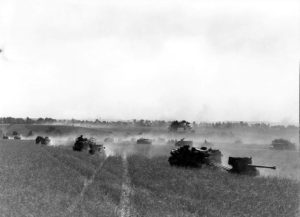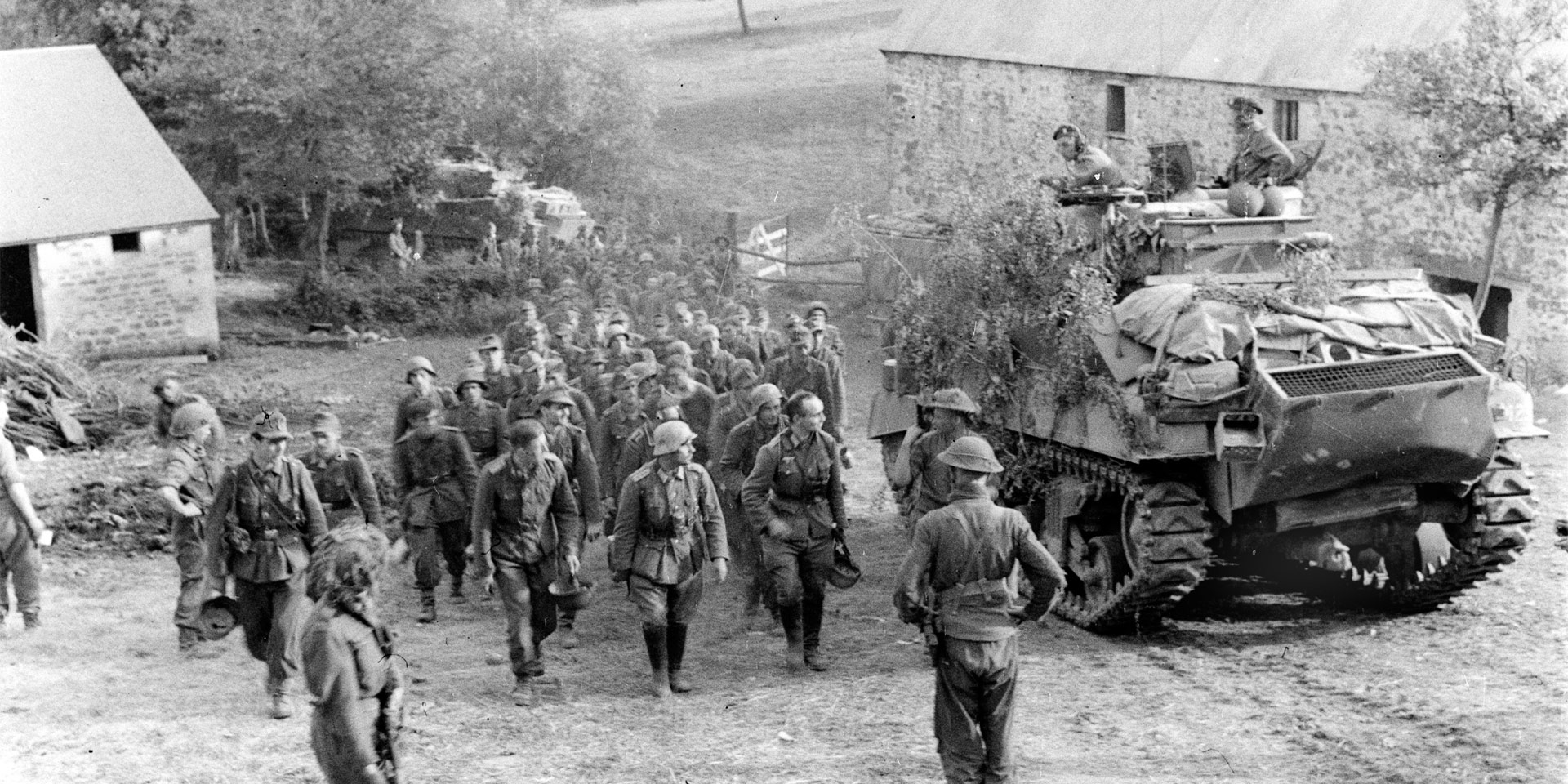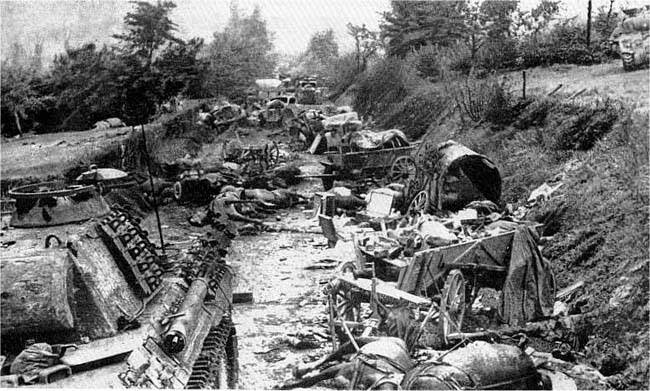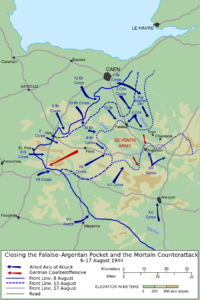
The Battle of the Falaise Pocket
The Battle of the Falaise Pocket was the final hammer blow in clearing out German forces in Normandy in the wake of the D-Day Landings.

The Battle of the Falaise Pocket was fought between August 12th and 21st, 1944. The Allied breakout following the beach landings was a phenomenal success, trapping the 7th German Army in an area just south of Falaise. This proved to be the decisive factor in Normandy, and effectively ended the campaign in the region. The victory enabled the Allies to race east and liberate Paris, far sooner than many had anticipated.
The Landings & The Breakout
Following the D-Day landings which commenced on June 6, Allied forces fought to expand the beachheads and consolidate their positions. The US forces under General Bradley sought to control the Contentin Peninsular whereas Commonwealth forces stalled in their attempts to reach and liberate Caen.
The protraction at Caen however, facilitated a plan by Field Marshall Montgomery to tie enemy forces up at that front, allowing the Americans to make a breakthrough. Thus on July 25th, with the assistance of heavy Allied bombing, Operation Cobra was launched. Bradley was able to surge through the St. Lo area with relatively little resistance and breach to the south and west. Subsequently, on August 1st, the 3rd US Army under General Patton gained ground in Brittany before pushing east.
German forces were instructed by Hitler to launch a counter-attack (despite protestations of more well-informed commanders), in an attempt to split the US forces and reach the west coast between Avranches and Mortain. This attack was repelled with relative ease and left the German 7th Army vulnerable
The Developing Pocket

Canadian forces moving toward Falaise on 14 August 1944
With the western reaches heavily favouring the Allies, Operation Totalize commenced on August 7th; which saw Canadian forces push south from Caen, to the hills north of Falaise. Von Kluge’s German forces thus faced Canadians to the north, British to the northwest, Bradley’s US forces to the west, and General Patton’s third army pushing from south.
There was disagreement amongst Allied Commanders as to how to exploit the situation. Eisenhower decreed that Allied troops should try to surround the enemy at Argentan. Patton obliged, securing Alençon and reaching positions overlooking Argentan on August 13th. Much to his dismay, Patton was ordered to withdraw slightly, as, by this point, Allied fronts were beginning to face each other directly. Canadian forces however along with the 1st Polish Armoured Division launched Operation Tractable, advancing towards Falaise and Trun.
Hill 262
By this time, orders were finally being issued for the German retreat, a course of action that Hitler was bitterly opposed to. The 7th Army and 5th Panzer Army were thus ordered to leave the pocket. On August 18, the Canadians captured Trun. Though a German attack broke a window in the Canadian line at St. Lambert, the pocket was soon reestablished. The 1st Polish Armoured Divison embedded itself on Hill 262, effectively entrenching themselves in the only escape route from the Falaise Pocket.

1st Polish Armoured Division moves South towards Falaise.
The Polish Division rained death and fire with artillery upon the narrow corridor that was the Germans’ escape route; all whilst defending against multiple large scale attacks. Despite their best efforts, 10,000 German troops managed to escape. They held their position until late on August 21st when Canadian forces reinforced and relieved them. That evening the gap was completely closed and the Falaise Pocket sealed.
Undoubtedly, the efforts of the 1st Polish Armoured division, under General Stanisław Maczek, had ensured the entrapment of the 7th German Army. In the fighting around Hill 262, German losses totalled 2,000 men killed, 5,000 taken prisoner and 55 tanks, 44 guns and 152 other armoured vehicles destroyed.

A Hawker Typhoon fighter-bomber observes a destroyed German column that had been attempting to escape the Falaise pocket.
Aftermath
There was some dispute whether or not more troops could have been caught in the pocket. Patton, for his part, maintained that had he been allowed to continue his advance, far fewer German troops would have escaped. Bradley opposed this idea, doubting Patton’s ability to hold any position had he advanced. Some blamed Montgomery for a lack of speed in moving his troops, believing British veterans ought to have taken the lead in light of poor Canadian performance.
Though total German casualty numbers are estimated at between 10,000 to 15,000, as well as 40,000 to 50,000 taken prisoner, it is believed that as many as 50,000 more managed to escape east. However, most would have done so without the heavier equipment and would have to be re-armed and equipped prior to their re-entry into the war.

One of many roads near Falaise in the aftermath of the battle. Many roads like this were nigh impassable.
The pocket itself was rife with the remains of the battle. Derelict equipment made many roads impassable. Piles of corpses; both soldiers and civilians, plagued the area, not to mention the livestock. Pilots reported being able to smell the stench of the battlefield hundreds of feet above it.
The battlefield at Falaise was unquestionably one of the greatest “killing fields” of any of the war areas. Forty-eight hours after the closing of the gap I was conducted through it on foot, to encounter scenes that could be described only by Dante. It was literally possible to walk for hundreds of yards at a time, stepping on nothing but dead and decaying flesh.
— Dwight Eisenhower
Nevertheless, the decisive German defeat brought an end to the Battle of Normandy and left the Allies free to pursue the liberation of the rest of Europe, beginning with Paris on August 24th 1944.
D-Day Overlord
Read more about the beginnings of Operation Overlord in this campaign book. With over 200 pages this tome allows players to take command of both Allied forces assaulting the beaches and inland defences and those of the axis manning such fortifications. It is packed with new, linked scenarios, rules, troop types, and Theatre Selectors providing plenty of options for novice and veteran players alike.

The post The Battle of the Falaise Pocket appeared first on Warlord Games.

